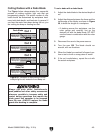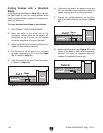
-38-
Model G0690/G0691 (Mfg. 11/10+)
If the pawls fail to return to the bottom position,
the pivot spring may have been dislodged or bro-
ken and will need to be fixed/replaced.
The anti-kickback pawls and arresting hooks are
constructed to comply with the UL Standard for
Safety for Stationary and Fixed Electric Tools, UL
987 (Seventh Edition).
Disabling Pawls
To disable the pawls, rotate the arresting hooks
downward, then place the pawls on each of the
hooks, as shown in Figure 52.
Use your best judgment before retracting the
pawls, as they are provided for your safety.
Certain situations could warrant retracting the
pawls. For example, you might retract the pawls
if you are concerned about them scratching a
delicate workpiece, or if you believe that they will
obstruct a narrow workpiece and cause feeding
difficulty or loss of control.
When to Use the Blade Guard
The blade guard assembly MUST always be
installed on the saw for all normal through cuts
(those where the blade cuts all the way through
the thickness of the workpiece).
When Not to Use the Blade Guard
The blade guard cannot be used on any non-
through cuts (those in which the blade does
not cut all the way through the thickness of the
workpiece).
Sometimes the blade guard or its components
can get in the way when cutting very narrow
workpieces or other specialized cuts. Because
the blade guard is provided to decrease your risk
of injury, it should not be used if it gets in the way
of making a safe cut. Use good judgment!
IMPORTANT: Whenever the blade guard cannot
be used, the riving knife must be installed.
Figure 52. Pawl disabled.
Arresting Hooks
(One Shown)
Pawl
Enabling Pawls
To enable the pawls, lift up on each pawl and
move them outward and down until they both
touch the table surface, as shown in Figure 51
on Page 37.
We do not recommend disabling the pawls
during normal operations unless absolutely
necessary. In most situations, disabling the
pawls will increase your risk of serious per-
sonal injury in the event of a kickback.


















